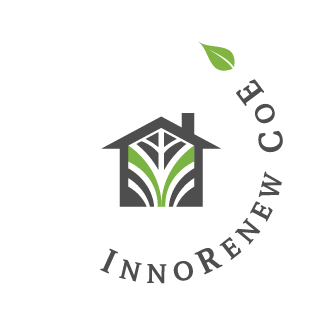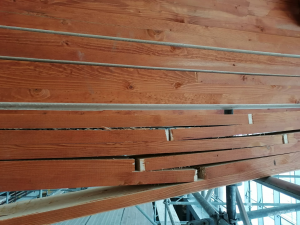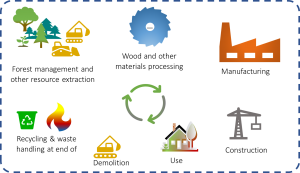
The InnoRenew CoE offers a range of services including performing basic and applied research, training and supporting industry members to utilise RDI in their businesses, helping companies develop new, modern business models, and assisting companies in winning research and business development funding through national and international funding opportunities such as the Horizon Europe SME calls.
We are eager to partner with other research institutes, companies, and academic institutes for international and national research projects from various funding sources.
Our areas of expertise include wood modification, human health, ICT use in the forest and construction sectors, sustainable building with renewable materials, and data oriented services.
InnoRenew CoE Laboratories
Laboratories
Characterization laboratory
The Characterization Laboratory offers complex, multiscale characterization of bio-based materials. State-of-the-art instrumentation is available for acquiring spatial, chemical, and time domain information through routine materials characterization and customized methods. This laboratory has preparation tools to pre-process materials for measurement and can perform solvent, distillation, pressing, and sublimation methods of extraction. Target compounds can be separated by flash and column chromatography, solvent evaporation or filtration, freeze-drying or heating, and ultrasonic treatments. This lab has instruments for comprehensive characterization of bioactive compounds and flash preparative and purification chromatography for challenging applications. Semi- or nondestructive techniques allow for characterization of hygroscopic properties, contact angle, surface tension, chemical composition, thermal stability, roughness, and color. Spectroscopic equipment is available for measurement and performance evaluation of materials, both in lab and in situ. Software for advanced data mining and development of chemometric models can be used for prediction of materials properties.
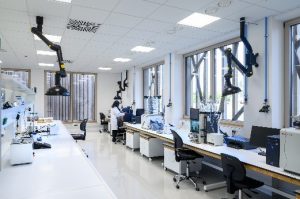
Photo: Miran Kambič
Microscopy laboratory
The Microscopy Laboratory houses equipment for microscopic analysis of materials, composites, and products to provide insight for improved quality, performance, and identification. For proper sample preparation, this laboratory contains a Leica TXP target preparation device and a TIC 3X Ion Beam Mill. These polishing and ion milling devices can transform even the most challenging composite materials into near-perfect surfaces suitable for examination at the smallest scale by this laboratory’s scanning electron microscope. The Microscopy Laboratory also contains a fluorescent microscope and a digital microscope for surface examination.
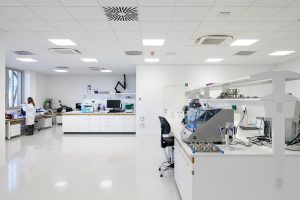
Photo: Miran Kambič
Physical Testing Laboratory
In the Physical Testing Laboratory we can assess the static, dynamic, creep, and thermal behavior of elastic, plastic, and viscoelastic materials. This laboratory has universal test machines and a creep testing machine with environmental chambers that allow investigation of short- and long-term viscoelastic behavior in natural materials. This lab is also equipped with in situ testing devices to assess building performance and component properties with micro- or nondestructive methods. The Physical Testing Laboratory can measure vibration periods and damping values as well as record precise 3D point clouds via laser scanning that can be used for further modelling or other parameter analysis, such as deformation measurements.
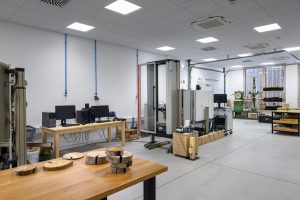
Photo: Miran Kambič
Acoustic Laboratory
Equipped with a 64-channel Ambisonics system, the Acoustic Properties Laboratory can record and reproduce acoustic environments under laboratory conditions to investigate human perception in a broad range of built environments—from offices to concert halls. This laboratory is fully equipped for field and laboratory measurement of room acoustic parameters, noise levels, and vibrations, including conventional and operational modal analysis. Measurement equipment, including two acoustic cameras, can be used to identify sound sources and transmission paths, sound absorption and transmission characteristics of materials, and impact noise levels and sound insulation ratings from field measurements. In addition, finite element and geometrical acoustic modeling software can be used to predict advanced room acoustics.
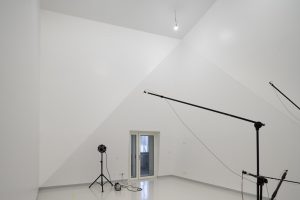
Photo: Miran Kambič
Composites Laboratory
The Composites Laboratory can produce composites via compression and thermo-hydro-mechanical treatments. Polymer blends and composites can also be manufactured through our flexible laboratory scale twin screw extruder and injection molder. In addition to conventional composite preparation, this laboratory contains state-of-the-art equipment that can produce thermochemically modified materials via torrefaction and carbonization, new adhesive formulations, and impregnated materials and composites.
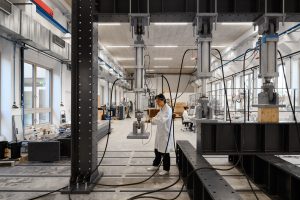
Photo: Miran Kambič
Advanced Manufacturing Laboratory
The Advanced Manufacturing Laboratory is a technological hub providing scientific support for a broad range of bio-based businesses as they adapt to Industry 4.0 and beyond. The research staff and equipment provide a unique foundation for the development of prototype software and hardware solutions that solve technical and theoretical problems associated with digital transformation. It includes digitalization of processes and quality-driven value chains as well as production engineering, modelling of complex systems and their optimization. The mechatronic development facility supports prototyping scanning systems for in-line characterization of biomaterials, as well as CNC additive/extractive manufacturing solutions adapted for bio-based technologies. A comprehensive set of hardware components allows rapid prototyping and demonstration for next generation automation of production processes including flexible collaborative robotics.
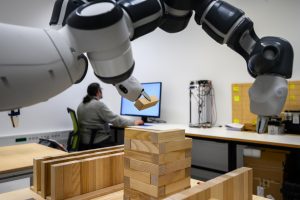
Photo: Miran Kambič
Engineered Living Materials Laboratory
The Engineered Living Materials Laboratory implements biomimetic principles for the development of new materials and modification processes. It allows fabrication and characterization of “smart”, active, or multifunctional materials composed either entirely, or partly, of living cells. The laboratory is equipped with various growth chambers, allowing fine control of microbial growth. An automated colony counter allows high throughput analysis of microbial colonies including differentiation by colour, size, and shape. The microplate reader can be used for cellular proliferation assays in fluorescence, luminescence, and UV-Vis. The stirred jacketed photobioreactor is suitable for growth of phototrophic organisms. It has a fully removable light module, which allows it to be used as a traditional fermenter/bioreactor.

Photo: Miran Kambič
Human Health Laboratory
The Human Health Laboratory can be used to conduct studies that relate building design, use, indoor environmental quality, and materials to human health, well-being, and performance at home, work, and school across demographics. This laboratory offers state-of-the-art equipment to monitor and assess psychophysiological indicators, neurological indicators, musculoskeletal performance, anthropometry, indoor environmental quality, human activity, and behavior. These aspects, in combination with mental health assessments, can be measured under specific laboratory-engineered environmental conditions and psychosocial settings to learn about human responses to stress, environmental conditions, and tasks.
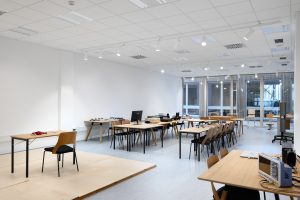
Foto: Miran Kambič
In-situ and laboratory measurements
Material and product testing and services
Thermal Analysis
Thermal insulation is a critical material for both new construction of buildings as well as retrofitting existing building stock to improve energy performance.
InnoRenew can measure thermal diffusivity/conductivity according to ISO 8301, ASTM E1530, and ASTM C518. Here, we have access to two devices depending upon the need. The FOX 314 is best used for measuring heat flux in panels, while the DTC 300 is well-suited to research work for material & product development of smaller samples.
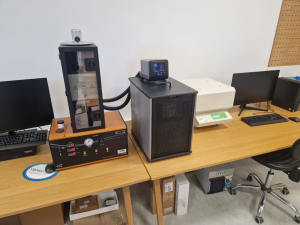
In-Field Analyses
When products cannot be sampled and brought into the lab, we can go to the product in the field and measure a variety of parameters.
InnoRenew can conduct field measurements utilizing our thermal camera, digital image correlation, resistograph, vibration exciter, and 3D laser scanner. These devices allow us to learn about energy performance in the building envelope, moisture leaks, structural integrity of beams and columns, deflection and load distribution in structures, vibration periods and damping values, as well as measure and recreate 3D pointclouds of environments for further modelling input.
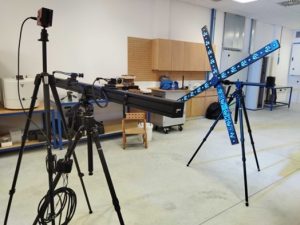
Static Mechanical Property Measurements
Static, mechanical testing is a staple of product development, modelling, quality control, and certification.
We can conduct static testing of materials in flexure, compression, and shear up to 100 kN. These tests can be conducted in a controlled environment (temperature and humidity) that encompasses the testing fixtures.

Dynamic Mechanical Property Measurements
Dynamic mechanical analysis (DMA) is a technique used to study the viscoelastic behavior of materials. Organic materials, like wood, natural polymers & adhesives, coatings, etc. fall into this category.
DMA is performed in either tension, compression, shear, or single/dual cantilever geometries. Specimens are exposed to loading in a cyclic manner and their dynamic response is recorded. In addition to oscillation, heat ramps can be applied to monitor the effect of changing temperature. From these tests we can learn the dynamic/complex modulus which can tell us important information regarding storage and loss moduli and the ratio between them (damping).
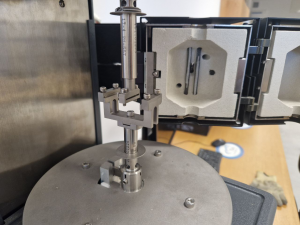
Acoustic
Dynamic Stiffness Determination
The ability of a material layer to be used as an impact sound insulation layer in floating floors is characterized by its dynamic stiffness. The dynamic stiffness is directly related to the improvement of the impact sound insulation of the floor and is therefore the most important acoustic parameter for impact sound insulation products.
In the Acoustic Properties Laboratory, dynamic stiffness is determined according to EN 29052-1:1992. For the test, square samples of 20 cm are used, which are subjected to a static load of 200 kg/m2.
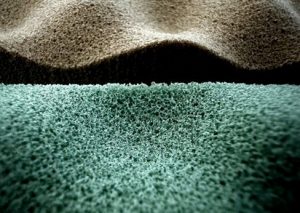
Airborne Sound Insulation Measurements
The airborne sound insulation of walls and floors is essential to achieve acoustic separation between rooms in a building. With sufficient sound insulation, privacy is maintained and independent activities in a building are made possible. The most important parameters characterizing the sound insulation of partition elements are the sound insulation rating and the sound level difference, both of which are generally specified as requirements for each specific building type.
The InnoRenew CoE acoustics laboratory team carries out field measurements of airborne sound insulation in buildings. The measurements are carried out in accordance with ISO 16283-1:2014 measurement procedure. The measurement results are also given as a single-number rating in accordance with ISO 717-1.
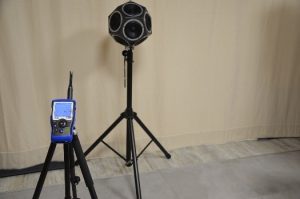
Listening Conditions Evaluation
Critical listening rooms, such as studio control rooms, require specific conditions in order to achieve the desired sound reproduction fidelity. The acoustic requirements are wide-ranging and include low background noise levels, a limited reverberation time of the room and the treatment of early reflections. In addition, the room geometry and exact positioning of the loudspeakers are important to optimize the frequency response at the listener’s position.
The Acoustic Properties Laboratory specialist can assess your listening conditions with on-site acoustic measurements. The assessment can be carried out in accordance with EBU Tech. 3276, but various customized acoustic measurements are also possible. Our specialists can also consult on possible improvements to room acoustics and the loudspeakers setup.

Foto:Miran Kambič
Acoustic Evaluation of Loudspeakers
Evaluating the acoustic performance of loudspeakers is important for assessing its sound reproduction fidelity and the optimal integration of loudspeakers into the listening environment. In addition, the determined loudspeaker specifications can be used to further improve the loudspeaker design and its components as well as to optimize the overall audio reproduction system.
Acoustic measurements of loudspeakers are performed under free-field conditions in our anechoic chamber according to EBU Tech. 3276 requirements. With our state-of-the-art equipment and facilities, we can accurately determine the frequency and phase response, directional characteristic, distortion, decay time and self-generated noise levels.
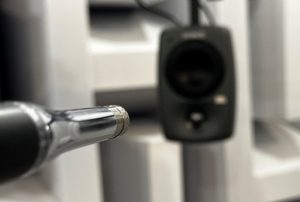
Sound Absorption Measurements
The ability of a material to absorb sound energy is crucial for any room’s acoustic design, as this property influences several room parameters, including reverberation time. The sound-absorbing properties of materials and products are quantified by the sound absorption coefficient, which lies from 0 for a completely sound-reflecting material to 1 for a completely sound-absorbing material. The coefficient is strongly frequency-dependent and is therefore specified in octave or one-third octave bands.
The sound absorption coefficients can be determined under the approximation of a diffuse sound field by measuring the effect of the sample on the reverberation time. The measurements are carried out in the InnoRenew CoE reverberation chamber according to SIST EN ISO 354:2004. The required size of the measured samples varies depending on the mounting conditions specified for the sample type.
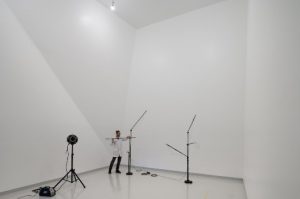
Foto:Miran Kambič
Airflow Resistivity Measurements
The specific airflow resistance of a sound absorber mainly influences its sound absorption coefficient. As such, it is valuable information in the development and performance optimization of any porous sound absorber.
The measurement of the airflow resistance of materials with open porosity is carried out on the basis of the static airflow method (DIN EN ISO 9053-1). The measurement is based on the evaluation of the pressure drop across the sample under investigation as a function of the volume airflow. Relatively small samples are required (disk samples with a diameter of 100 mm), which makes the method ideal for prototyping.
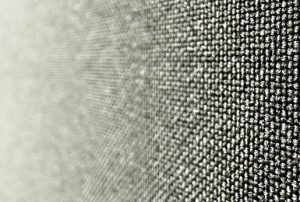
Impedance Tube Measurements
Impedance tube measurements are suitable for the acoustic characterization of relatively small material samples (disk-shaped samples of 29 and 100 mm diameter are required). Such samples are easy to produce, making this measurement method ideal for product development and prototyping.
The Acoustic Properties Laboratory carries out several impedance tube measurements, including the determination of the sound absorption coefficient for normal sound incidence and the determination of the acoustic surface impedance (ISO 10534-2). In addition, the transmission loss of porous materials can also be determined (ASTME2611–17).

Impact Sound Insulation Measurements
The predominant source of impact sound in buildings is caused by walking, where the foot/shoe directly excites the floor. The corresponding vibration propagates through the structural elements of the building, making impact sound one of the most disturbing types of noise in buildings. The impact sound performance of a floor is characterized by the impact sound level, which is usually also specified as a building requirement.
The InnoRenew CoE acoustics laboratory team carries out impact sound insulation measurements on site. The impact sound levels are measured in accordance with the ISO 16283-2:2014 using a standardized impact sound source (tapping machine).
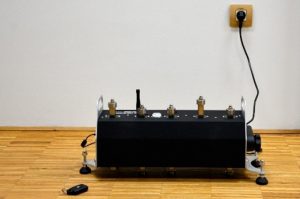
Speech Transmission Index Measurements
High speech intelligibility is of central importance for rooms used for speech-related activities, such as lecture halls, auditoriums and theaters. In addition, speech intelligibility must also be high for public address systems which can convey various important information, including warnings. The most commonly used acoustic parameter to quantify speech intelligibility is the Speech Transmission Index (STI) and its counterpart STI-PA for public address systems.
The index is measured according to IEC 60268-16:2020. In the case of unamplified speech, an artificial speaker (talkbox) is used, while a PA system is used for its assessment. In our acoustics laboratory, we are able to carry out all of these intelligibility measurements and consult on how to improve intelligibility.
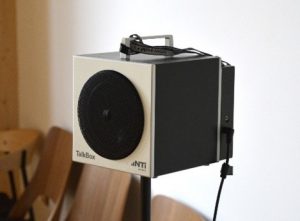
Noise Source Discrimination
Noise sources commonly consist of several noise-generating components that produce sound simultaneously. Such complex sources are difficult to assess because it is impossible to discriminate the individual components from each other with conventional measuring devices, such as a sound level meter. On the other hand, such an assessment is possible when microphone arrays are used.
The Acoustic Properties Laboratory team can access complex sound sources using the microphone array integrated into the acoustic camera. Beamforming and acoustic holography algorithms can be used to discriminate the sound emission of different noise components. In this way, different noise source components can be identified and assessed independently, including by measuring their individual acoustic intensity. The assessment can be carried out on site or, if the sound source is portable enough, under free-field conditions in our anechoic chamber.

Sound Transmission Pathway Identification
If the sound separating element, such as a wall between two rooms, consists of several parts, it is a challenge to determine which represents the dominant sound transmission path. Conventional acoustic measurement methods, such as using a sound level meter, cannot provide this information, but microphone arrays can.
InnoRenew CoE’s state-of-the-art acoustic camera, which is based on a beamforming algorithm, can be used to discriminate the contribution of the different sound transmission paths. This approach can be used to identify air gaps and sound bridges on walls, for example. On this basis, targeted and cost-effective measures can be taken to improve the sound insulation of the separating element.
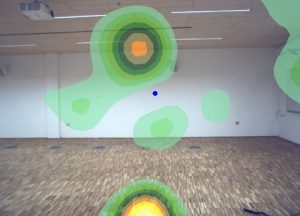
Evaluation of Vibrations
Vibrations can have various undesirable effects, such as causing discomfort, endangering health and interfering with sensitive equipment. Vibrations are present outdoors in the built environment and also in certain equipment and machines.
In the acoustics laboratory, we acquire vibrations with uniaxial and triaxial accelerometers. Our Doppler laser vibrometer is used for non-contact measurement. Which measurement approach is used depends on the purpose of the measurements: The assessment of human exposure to whole-body vibration, for example, follows the ISO 2631 family of standardized measurement procedures.
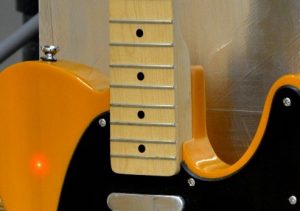
Products Evaluation Through Listening Tests
Each sound-generating device can be evaluated by a specially developed listening test. Such an evaluation provides a complementary insight to technical acoustic measurements which quantify acoustic performance and characteristics with various parameters. Instead, listening tests can provide insight into what perceptual preferences users have for a particular sound source, e.g., a vacuum cleaner or a loudspeaker system.
As part of the evaluation, a sufficiently large and precisely defined group of test subjects give their response after listening to various sound samples. The listening takes place in a critical listening environment in which the sound samples are reproduced in random order and the listener has no information about the sample to be evaluated. Such a test setup avoids several naturally occurring biases and must be carried out by an interdisciplinary group of experts, including acousticians and psychologists.
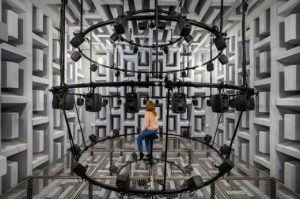
Foto:Miran Kambič
Dynamic Response of Structures
The dynamic characterization of structures is important in different contexts and at different scales. In the context of our investigations, we are dealing with noisy machines, musical instruments and even entire buildings. In all these cases, the identification of the natural frequencies of such systems and the corresponding modal shapes is necessary to understand and optimize their dynamic performance.
We perform operational and experimental modal analysis of structures by acquiring the response with uniaxial and triaxial accelerometers and a Doppler laser vibrometer. Modal hammers of different sizes, a modal shaker or a mass shaker can be used for excitation. With the subsequent analysis, natural frequencies, modal shapes and damping ratios can be extracted and visualized.
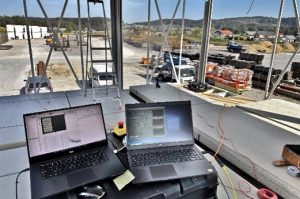
Structural measurements
Long-term Creep Test of Construction Materials and Structural Elements
Some construction materials, e.g., timber, concrete, and certain composites, and structural elements made with them tend to develop time-dependent deformation when they are exposed to sustained loads for an extended time. This phenomenon is known as creep and could be influenced by variation in environmental conditions as well. Creep deformation can negatively affect serviceability in structural elements and functionality in non-structural elements of structures. Excessive creep in certain applications might also lead to early failure. Therefore, the effect of creep is taken into account in the design of structures.
Bending creep tests (with unlimited span) and shear creep test of large-scale construction materials or structural elements can be carried out in the Composites Laboratory. Similar tests for small-scale specimens can be carried out in the Physical Testing Laboratory under various temperatures and relative humidities on request.
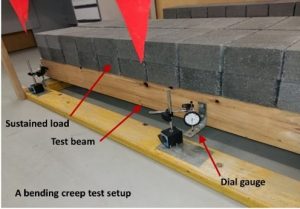
Testing of Short-term Mechanical Properties and Load-carrying Capacity of Construction Materials and Structural Elements
Evaluation of short-term mechanical properties of construction materials and structural elements includes a wide range of static testing, such as bending, tension, compression, shear, friction, and other mechanical tests. Such testing might be needed as part of materials selection for a construction project, structural design calculations, quality control and assurance, compliance with codes and regulations, research and development, etc.
The short-term mechanical properties of small-scale material specimens (e.g., timber, concrete, steel, and composites) or structural elements are tested using universal test machines that are available in the Physical Testing Laboratory. The small-scale specimens can be tested at normal room temperature or at variable temperatures ranging from -30 °C to 180 °C. For testing of large-scale specimens (e.g., beams, columns, floors, walls, etc.), a set of three hydraulic actuators and a sophisticated test setup equipped with strong floor are available in the Composites Laboratory. Linear Variable Differential Transformers (LVDTs) and Digital Image Correlation (DIC) tools are available for measuring deformation. Expert analysis of test results and failure modes is provided as well.
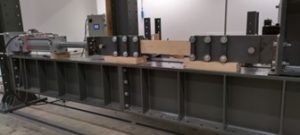
Testing of Short-term and Long-term Mechanical Properties of Structural Connection Systems and Fasteners
Connections play a major role in the design and performance of structures and are often made with screws, bolts, nails, dowels, and other metallic or non-metallic connectors. The knowledge on the short-term and long-term mechanical properties of connections and fasteners helps designers and engineers understand whether a connection system can fulfill the performance requirements specified in relevant building codes and or other regulations.
A range of specialized tests for fasteners and connection systems is provided in our Physical Testing Laboratory and Composites Laboratory. This includes screw or nail withdrawal tests, bending tests of fasteners, tension tests, shear tests, cyclic tests, fatigue tests, creep tests, and other relevant test combinations. Testing can be done under room environment or under variable environmental conditions on request.
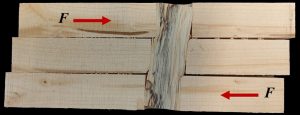
Static, Dynamic, and Creep Behavior of Elastic, Plastic, and Viscoelastic Materials
Timber used in construction (whether it is in its natural state or not), in engineered wood products or that is modified in some way, will be exposed to long-term loading and will thereby exhibit creep deformation and, in extreme circumstances, lead to early failure of the structure or at least give a negative impact on the serviceability during its service life.
The Physical Testing Laboratory has can carry out creep tests in a custom KAPPA Multistation testing machine (Zwick GmbH & Co. KG, Ulm, Germany), able to accommodate five specimens simultaneously. The test procedure can be designed based on EN 1156:2013 and ASTM D6815-22. In addition to standard tests, the maximum loading force is 10KN, ambient temperature -30 ° C to + 180 ° C and relative humidity 20% to 90%.
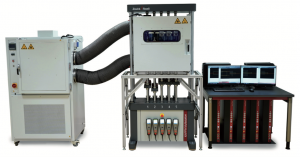
Fatigue Test of Construction Materials and Structural Elements
Fatigue test is aimed to evaluate the mechanical performance of materials or structural elements under repeated loading and unloading cycles. Such cyclic loading simulates the real-world conditions that a material or a structural element might experience in service, which helps to understand how they behave and withstand cyclic loading, ensure their safety and reliability, and predict their potential service life in certain applications.
Fatigue tests can be carried out in the Physical Testing Laboratory for small-scale material specimens and in the Composites Laboratory for large-scale structural elements. This includes various types of common loading types such as bending, shear, tension, compression, and lateral loading. Expert failure analysis and data evaluation are provided for the tests.
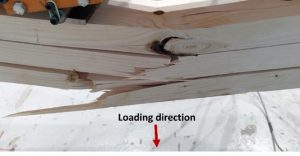
Characterization of Structures (e.g., 3D Scanning)
In projects that involve renovating or refurbishing existing buildings, precise data about the existing architectural setup are of paramount importance, even more so if the building or structure in question is older and the original project documentation is lost. If such buildings are protected as cultural heritage, precise documentation of the existing state is needed to plan conservation interventions sensibly and effectively. 3D scanning is a distance sensing and non-invasive inspection technique, that can greatly help with such tasks.
3D scanning is executed on-field with using our 3D laser scanner, that uses a laser to determine the distance between itself and the scanned surfaces. The result is a group of points recreated in a digital 3D environment, that is commonly referred to as “point cloud”. A point cloud can be the base to produce a full 3D model, it can also be used to create cross-sections, extrapolate details, make measurements etc. A 3D laser scanner enables the user to make 360-grade photographs of the scanned areas.
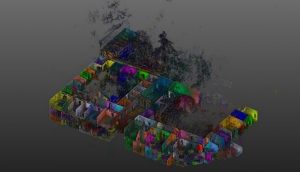
On-site assessments
Mould Growth in Buildings
Moulds are form of fungi that produce spores and usually grow in places with a lot of moisture. Some fungal species cause deterioration in building materials. Some can be harmful to our health and produce spores that can cause respiratory symptoms and infections, allergic reactions and other immune disorders and, to a lesser extent, neurological problems. Identifying muold growth in buildings is critical to remediation and establishing healthy living environment.To determine mould growth in buildings, we use directly sample surfaces with swabs. After sampling, the samples are inoculated on various types of growth media for mould fungi.

Indoor Air Quality Monitoring
Indoor Air Quality (IAQ) monitoring is an essential tool to ensure wellbeing, comfort, and health in the built environment. Web technologies and low-cost sensors enable collecting, analyzing and learning about IAQ in selected locations in buildings.
The Information Processing Research Department has expertise in designing wireless sensor network solutions based on our own tailored smart sensors that can potentially incorporate on-sensor computation and support Indoor Air Quality (IAQ) data collection, processing, storage, and analysis. Our solution, offered as a service, allows environment classification and assessment from real-time values and historical trends and histograms. Such advanced data processing and presentation can be used to benchmark buildings, individual rooms, or households with respect to IAQ. It is adjustable to a diversity of use cases and provides both user-friendly data visualization and raw data download for further analysis.
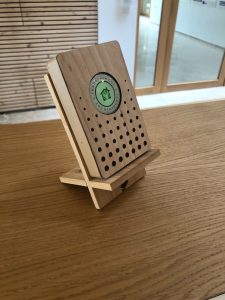
Air Quality (Microbial Contaminations)
Microorganisms are all around us, but some can be harmful to our health. In particular, spore-forming fungi can cause respiratory symptoms and infections, allergic reactions and other immune disorders and, to a lesser extent, neurological problems. Some types of fungi also synthesize mycotoxins, which can be carcinogenic or acutely toxic. By taking air samples, we can identify potentially pathogenic fungi, which is the first step towards the solution for better air quality.
To assess microbial contaminants in the air, we use an air sampler. In air sampling, a known amount of air is forced through a sampler onto a Petri dish containing different types of growth media for fungi.
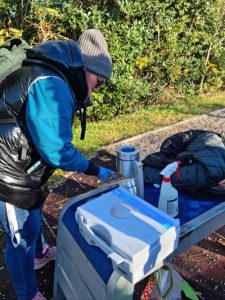
Advanced manufacturing
Advanced manufacturing
Implementation of ABB Cobots To Processes
As industries evolve towards smarter and more efficient processes, integrating collaborative robots, or cobots, becomes pivotal for sustainable growth. In recognizing the transformative potential of ABB cobots, our department stands ready to be your strategic partner in this journey.
In the pursuit of elevating your operational efficiency, our service for the implementation of ABB cobots is your gateway to a future where automation and collaboration seamlessly coexist. Leveraging the capabilities of ABB Yumi and ABB Gofa, and guided by our team of ABB Certified programmers, we tailor the integration process to your unique needs. From meticulous planning to hands-on implementation, our approach is centred on enhancing your processes. Whether it’s optimizing repetitive tasks or augmenting precision, we ensure that ABB cobots become integral to your workflow. By choosing us, you’re not just investing in technology; you’re securing a partnership dedicated to unlocking the full potential of collaborative automation. Embrace efficiency, embrace innovation – let our expertise pave the way for your business to thrive in the age of advanced robotics.
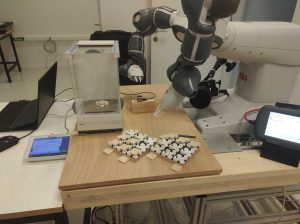
Polymer Extrusion
Development of nature friendly alternatives to plastic seeks use of alternative materials, with bio-based origin and different blending mixtures. Our knowledge and innovation in the field of natural and materials science offers state-of-the-art material processing and customized solutions for research in biomaterial materials.
We provide extrusion and injection molding for material properties characterization of polymers-based mixtures with biobased materials. The scale is appropriate for small batch testing or extruding larger amounts for support in adjusting technological parameters.
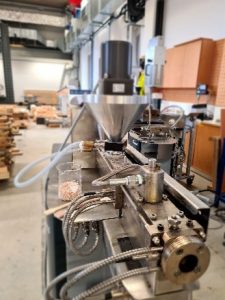
Characterization of Machinability and Cutting Process Optimization
The majority of the modern industrial processes for biomaterials’ conversion are implemented as varying options of the cutting operations. The physics of these cutting processes is very complex and depends on the material configuration, cutting tool used, process kinematics and setting, among others. Creating high quality products, including optimal surface topography, requires very wise machining with proper tools and well-adjusted cutting/feed speeds.
The unique research facilities at InnoRenew CoE allows complex evaluation of the machinability for diverse materials as well as identification of recommended tools and process kinematics. All the relevant aspects are simultaneously assessed, including cutting forces, emissions, residuals characterization as well as mechanical properties of resulting products. Complete surface characterization, including topography/roughness, geometric accuracy, chemical-physical properties, aesthetics, haptics and overall quality can be also provided.

Additive Manufacturing with Biobased Materials
3D printing is an alternative technology to machining and other cutting processes. A broad selection of printers at diverse sizes, working principles, and cost are available on the market and frequently adopted by manufacturing industries. Unfortunately, the majority of materials used for printing are not sustainable and the process itself can be time consuming and expensive. Use of biological-origin materials is therefore a desired direction for further advancing the additive manufacturing sector.
InnoRenew CoE offers immediate access to a complete set of tools enabling developments of alternative 3D printing technologies, including novel filament materials, alternative fillers, innovative extrusion scenarios, fabrication of 3D printed components at diverse scales, mechanical testing of prototypes as well as optimization of the 3D component’s geometry.

Automation and Optimization of Production Processes
Modern wood industries are under continuous pressure from global competitors to become more efficient by reducing production costs, increasing productivity and manufacturing customized small series of superior quality products. These demands call for for automation and optimization of production processes.
The research team at InnoRenew CoE is able to co-create Industry 4.0 solutions for wood industries of different sizes. This service is combined with overall evaluation of the company toward digitalization, data driven execution of production and integration of the latest production engineering solutions and/or automatic machinery.
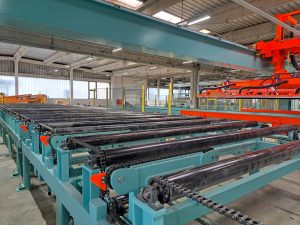
Design, Simulation and Fabrication of Prototype or Small-series Custom Products
The market requires great flexibility from companies along with competitive prices. The demand for production of small product series, that are highly customized and delivered in a very short time is increasing. It includes new products or supplementary items accompanying the main products portfolio. In several cases it is not economically sustainable for the company to manufacture such small batches or unconventional products, justifying outsourcing of production. It is especially valid in cases of more complex orders requiring not only fabrication but also custom design, simulation and testing.
InnoRenew CoE accepts outsourcing for small series of sophisticated products that can be manufactured in laboratory-like environments. The offer includes preparation of technical documentation, technological processes, fabrication, testing and integration, among others.
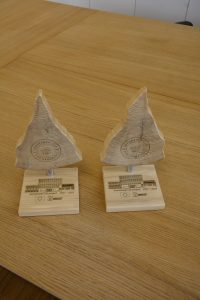
Robotics Large-parts Machining
In modern manufacturing, the challenge of producing large parts with finesse is an ongoing pursuit. Recognizing the complexity and intricacies involved, our department stands as a hub for those seeking a breakthrough. Imagine overcoming the hurdles of crafting sizable and complex components effortlessly – this is precisely where our expertise in industrial robotics comes into play.
Our large-part machining service, centred around an ABB robot IRB 6620, is a testament to our commitment to technological excellence. The robot’s 4-meter rail ensures expansive coverage, allowing for intricate machining operations on diverse workpieces. The myElte 7.5kW spindle, coupled with a force sensor, guarantees a high level of precision and adaptability, making it well-suited for applications in wood and plastics machining. The addition of a rotation table further enhances the system’s versatility, enabling the fabrication of complex shapes with ease. Moreover, our expertise extends beyond physical machining, as we possess the capability to 3D model intricate and large components, ensuring a seamless transition from design to fabrication. With a focus on innovation and quality, our large-part machining services stand as a beacon for those seeking advanced manufacturing solutions in today’s dynamic industrial landscape.

Research and development services
Research and development services
Development of Prototypes (Machines and Scanners)
Modern industries require data-driven production execution that requires integrating sensors, controllers, machines and data processors. In most cases such solutions are not available on-the-shelf and require custom approach for design, prototyping, manufacturing and integration with existing production lines, without interfering with the ongoing processes. On-line canners for detection of the wood quality as well as other machine components/modules are typical examples of such components. Moreover, in-house quality assurance departments often lack of the properly implemented laboratory instrumentation that must be prototyped to fit the specific needs of the company.
InnoRenew CoE offers a complete solution to address the above challenges by understanding the specific needs of the company, designing the solution, simulation, fabrication, integration and validation. It includes both, hardware and software components as well as incorporation of the prototype into production facility.

Modification/Functionalization Treatments of Bio-Based Materials
To broaden their applicability and remain competitive, bio-based materials need to improve several of their properties, such as dimensional stability, thermal stability, fire resistance, biotic and abiotic degradation resistance, and mechanical properties. This brings new solutions to the market that assure expected properties and functionality over elongated service lives and reduce the risk of product failure. Wood modification processes enhance desired properties by applying chemical, biological or physical agents.
We offer a broad portfolio of various modification treatments and related assessment tools: thermal and chemical modification, densification, impregnation, and various surface treatments.
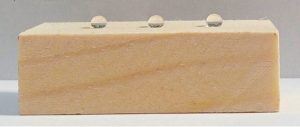
New Innovative Structural Elements
The modern construction sector relies on innovation, efficient use of resources, more economic production, elongated service life durations and attractive appeal of buildings. Wood as well as other bio-based materials have a great potential to become the primary resource for buildings of the future. However, further innovation in its use, modification of chemical/physical properties, adaptation of connection/joints, increased durability and assured rheological performance are some of aspects that must be carefully addressed before broader expansion of these technologies.
InnoRenew CoE offers a wide ranging services related to parametric design, subtractive design, structure optimization, long-span elements, innovative assemblies configurations, ultra light construction, hybrid solutions, seismic/flooding/wind resistant structures and others aspects.
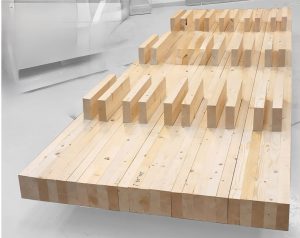
Testing of Coatings and Adhesives
Wood and wood coatings are usually tested in accordance with EN 927-3 (natural ageing in the exterior), EN 927-6 (accelerated aging in UV chambers with water spraying).
We offer performance assessment according to standards by evaluation of following properties: specular gloss assessed by glossmeter, colour and calculation of colour difference in CIELAB colour coordinates with illuminant D65 by colorimeter, paint adhesion by tape and a cutting tool, assessment of surface defects with microscope with various magnifications of ×10, film thickness and chalking by self-adhesive, transparent tape.
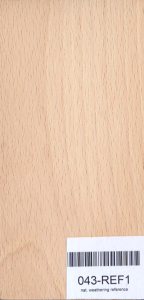

Development, Deployment and Management of Wireless Sensor Networks
Large scale wireless sensor networks require continuous management, efficient and robust data storage and privacy preserving communication protocols.
The Information Processing department has the expertise and capacity to plan, build, and deploy large scale wireless sensor networks. Our solution is a custom built set of tools and protocols that enable seamless integration with well established IoT monitoring platforms and are built with extendibility and scalability in mind. We can integrate custom analogue and digital sensors as well as off-the shelf sensors. On the management level, we offer many features for building monitoring such as visualization, data export and analysis, custom alerts based on thresholds, and remote software updates.
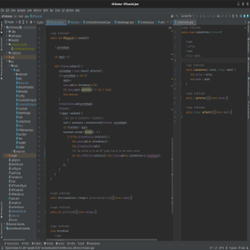
Manufacturing Complex Products
Modern customers desire high-quality products with advanced functionalities and a unique profile. This requires broad range of engineering experts to design, test and manufacture novel products. It is especially relevant when not only wood/biomaterials are involved, but when these are combined with metals, plastics, ceramics (among others). In addition, integration of sensors, actuators or any other mechatronic systems is frequently expected by clients.
InnoRenew CoE offers co-creation or complete manufacturing of complex products, assuring timely delivery and optimal product quality. Complex manufacturing can be performed in the collaborating company premises, in-house, or in cooperation with external partners.
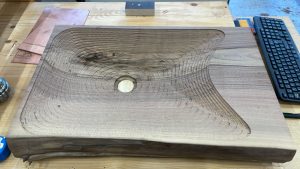
Design for Disassembly Solutions
The Circular Economy is one of pillars for assuring highest sustainability of the construction sector and improving its climate impact. Even if wood and biological-origin materials have a great potential for reuse/recycling, most existing uses have a short service life durations and are frequently converted to energy or land filled. The engineering challenge is therefore to develop new approaches promoting elongated service life, cascade use and in optimal scenario re-use of structural components in future buildings.
The broad know-how on biomaterials, civil engineering, production technologies, architecture and sustainability makes InnoRenew CoE a perfect partner to co-create alternative construction systems enabling re-use of embedded materials. The key element is ability to easily recover materials at the end of the service life. Design for disassembly is a recommended solution.
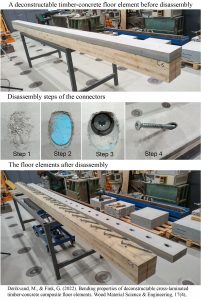
Pre-certification Testing
Each product intended for construction on the European Market requires certified conformity with legislation and relevant building codes. The process of obtaining such certification is complicated, time-consuming and costly. In many cases this is a burden for the company delaying the release of the new product as well as consuming valuable human resources for certification activities.
InnoRenew CoE has documented experience in preparation of EU certifications, including all legal and technical aspects of the process. We can assist or represent companies in the accreditation procedure allowing them to focus on the production and marketing of their products.

Large Network Analysis and Modeling
Information systems generate large amounts of data either through interaction between humans and computers, machine to machine or simply data that describes a state. In all of the above cases, data can be viewed and modeled as a graph/network. These networks inherently store valuable knowledge, which is usually obtained through modeling and information retrieval. However, large networks introduce a considerable increase in computational complexity making them infeasible to process.
As part of our past and ongoing research, we developed a set of software tools and custom algorithms that help us tackle large graphs and make information retrieval feasible. These tools include visualization of large networks, clustering and decomposition, simulation and agent based modeling as well as traditional traversal techniques. To achieve this, we make use of custom developed algorithms that are designed for distributed computation. Integrated business intelligence solutions are specifically designed for a company’s workflow.
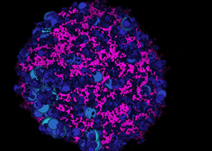
Development of Decision Support and AI modules for Information Systems
Decision making and process planning is a complex task with multiple factors influencing the company’s operational costs, capital expenses, and environmental footprint. In this context, business challenges require intelligent data and process analysis. Since companies use customized information systems it is a common requirement to develop and integrate an AI and optimization based decision support module for the specific needs.
Our service is based on a comprehensive understanding of the company’s domain, followed by an in-depth analysis of its processes, regulations, and material flow. Using this information, we establish computational models designed to optimize production schedules, employee assignments, and other company-specific challenges efficiently. The outcome is a variety of scheduling options tailored to any given use-case. These options can assist company experts in making informed decisions and planning long-term schedules, thereby enhancing operational efficiency and reducing environmental impact.
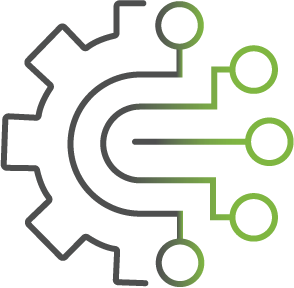
Wood Processing from Log to Finished Product
Our workshop is equipped with state-of-the-art machinery operated by skilled craftspeople, offering a range of custom wood processing solutions for various industries. Whether you’re a furniture manufacturer, a construction professional, or a woodworking enthusiast, we provide tailored services to bring your wood projects to life.
We have dedicated equipment for precise wood processing from large scale logs using our Woodmizer to fine contact sanding. This allows fine personalization to our customer’s needs. InnoRenew CoE experts will address and find solutions for surface finishing, gluing and assembly of your materials or products.
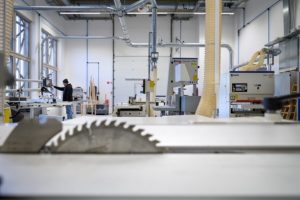
Consulting
Consulting
Timber Solutions Consultation
Timber solutions consultation provides expertise, guidance, and advice to address certain challenges that might be associated with the production, design, testing, and implementation of timber-based solutions or product developments.
Expertise and consultation services are available on the following topics:
- Production of laminated timber products and structural elements, including cross-laminated timber (CLT), glue laminated timber (GLT), dowel-laminated timber (DLT), and nail-laminated timber (NLT).
- Design and fabrication or prefabrication of timber-concrete composite systems.
- Design for deconstruction and reuse of hybrid timber-concrete composite systems.
- Product development from salvaged wood and post-consumer wood.
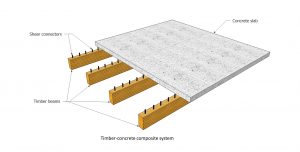
Building Construction Supervision and Monitoring Wood Moisture
Wooden construction must be monitored in such a way as to prevent excessive wetting of the constructions, to allow the structural wood to dry sufficiently before covering it with new layers, and to enable the most efficient and fast execution on the construction site.
Our planners supervise the execution of wood-based construction to prevent excessive wetting of wood. With the help of wood-moisture monitoring, both on the surface and in the depth of the wood, can recommend implementing further layers on the building envelope. Construction supervision also includes other aspects, such as the control of the quantities of materials, verification of technical properties of the materials proposed by the contractor, inspection of accounting and inventory records and the fulfillment of essential requirements of construction.
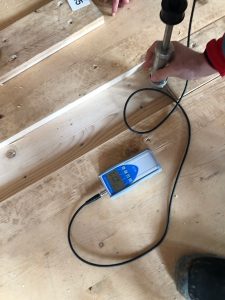
Acoustic Consulting for Building Sound Insulation Calculations
High airborne sound insulation of walls and floors is essential to achieve acoustic separation between rooms in a building. With sufficient sound insulation, privacy is maintained and independent activities in a building are made possible. The most important parameters that characterizing the sound insulation of partition elements are the sound insulation rating and the sound level difference, both of which are also generally specified as requirements for each specific building type.
Due to regulations, the sound insulation performance of a building must be evaluated in a dedicated report during the construction planning phase. This can be done with the help of laboratory measurement results, with computational approaches and also with computer simulations. All of the above approaches can be carried out by InnoRenew’s experts, who can also advise on various building details from an acoustic perspective.

Statistical Consulting
With the increasing volume of accessible data, statistical knowledge is crucial for businesses and other organizations seeking informed decision-making. In today’s data-driven landscape, statistical consulting plays a pivotal role in distilling complex data into actionable insights. The ability to interpret and apply statistical analyses fosters a deeper understanding of business dynamics and contributes to strategic planning, resource allocation, and overall operational efficiency.
Our experts in statistical methodologies can assist you in collecting, organizing, analyzing, and interpreting data. By uncovering patterns, trends, and correlations within your data, we will help you enhance the accuracy of decision-making processes, identify opportunities, and effectively mitigate risks. This can be applied to market research, forecasting, quality control, and performance optimization.
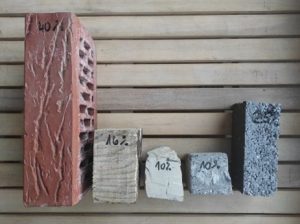
Manufacturing and Production Process Arrangements
The key requirement to assure the profitability of industry is continuous optimization of technological processes, services and products. It can be realized by improving productivity, maintaining the highest product quality and reducing costs. For that reason, the arrangement of the current technological process should be carefully examined and whenever justified, upgraded or modified by adopting the latest solutions.
The multidisciplinary research team at InnoRenew CoE is constantly monitoring the state-of-the-art market status by active involvement in diverse international technical associations, participating in the fairs and scientific conferences as well as conducting various R&D projects. It guarantees access to the most advanced technologies by integrating solutions from the market, or development of proprietary solutions in direct collaboration with the company.
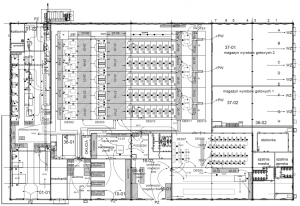
Post Occupancy Evaluation of Buildings with an Emphasis on Health and Wellbeing Outcomes
Assess the reactions and perceptions of building occupants to your building - public, or private.
InnoRenew Coe offers design and analysis of questionnaires to assess the impact of the building and environment (physical, work, social) on occupant health, wellbeing, and performance.

Acoustic Design and Consulting
Rooms intended for different purposes usually require different acoustic conditions. These can range from acoustically very lively and reverberant environments for classical music styles to dry and anechoic conditions in a recording studio. Common room acoustic measures consist of reducing the reverberation in the room, as is the case with loud machines. In classrooms, lecture halls and other spaces used for verbal communication, high speech intelligibility is of central importance. In addition, there is a long list of acoustic requirements for venues for musical performances, such as concert halls.
Within our expertise and with several successful projects as reference, we carry out high level acoustic design for a variety of spaces. As part of the design, the desired acoustic performance of the space is defined, room acoustic simulations are used for predictions, while elements of acoustic treatment (solutions) are defined. These can be defined in the form of prefabricated products or as a project-specific design, for which prototyping and acoustic evaluation can also be carried out. In addition, auralization samples can be created based on acoustic simulations to evaluate the acoustic design by listening.
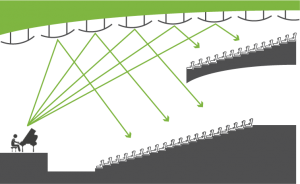
Software System Design and Implementation
When “off-the shelf” software solutions are not available because of specific requirements, then customized solutions are needed for software architecture and system design.
The set of services offered by our team cover all processes required to develop customized software solutions from start to finish. Typically such software services include but are not limited to high performance computing, custom complex workflow modeling, optimization software, distributed/decentralized computing solutions as well as machine learning and AI based business solutions.

Expert Evaluation of Survey Questionnaires & Survey Design
Survey questionnaires play a pivotal role across diverse domains, spanning from academia to industry. Crafting effective survey questions, however, is a nuanced process requiring careful consideration of both conceptual and technical aspects. Attempting a do-it-yourself approach to develop surveys, devoid of input from individuals possessing the necessary experience and skills, often results in the generation of subpar data. The intricacies involved in the art of questionnaire design necessitate a collaborative and informed approach for ensuring the quality of the collected information.
Our survey methods experts possess a deep understanding of survey design methodologies and are proficient in a variety of techniques to assess questionnaire quality and propose improvements. By employing a range of qualitative and quantitative analysis, and user experience testing, we can provide a comprehensive assessment of your survey instrument. We have a strong track record particularly in developing and evaluating survey questionnaires on topics related to architecture and buildings, innovation, and sustainability.

Analysis of Manufacturing Processes and Possible Augmentations
The manufacturing of products made from bio-based materials requires specific technological solutions that are frequently proprietary and customized for the needs of specific factory. In many cases these solutions, even if working properly, are not up-to-date. This may lead to reduced economic gains, increased costs and/or not necessary production of residuals. The direct access to the latest know-how and technological developments may lead to augmentations of previous-generation processes, re-arrangements, and/or investments into new technological solutions.
We offer our collaboration in objective assessment of your production processes with a special focus on identification of weaknesses and bottle necks. The diverse experiences of our scientific staff and up-to-date knowledge on broad technological developments in the field allows to us assess and propose optimal augmentations.
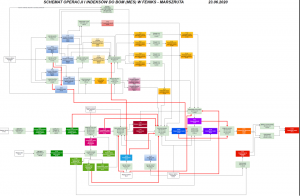
Implementation of IT Solutions for Production Engineering and Planning
The Industry 4.0 paradigm requires digitalization of production and data driven manufacturing. It is a great challenge for companies, especially those of small or medium size. The implementation of ERP/MES/APS systems is a complex process that requires multidisciplinary knowledge to combine technological, financial, marketing, procurement and human resources aspects. A key for the success of these technologies is a proper and realistic preparation of the pre-implementation analysis.
The interdisciplinary team at InnoRenew CoE offer comprehensive assistance in formal description of the technological process and uses of resources. It is closely related to the MRP implementation in the factory, but also to optimalization of technological processes, simulation of alternative production approaches, and supporting investment decision-making. The overall goal is to increase company’s revenue, reduce costs and maximize raw material efficiency.
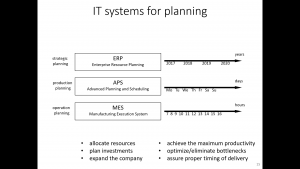
Architectural Consultation on using wood to Meet Health and Wellbeing Goals
We consult and inspire clients to build and design buildings according to the building design paradigm Restorative Environmental and Ergonomic Design (REED). This paradigm can provide guidance for architectural design focused on multiple aspects of sustainability: environmental, social, individual wellbeing, and economic. Individual wellbeing is enhanced through the restorative capacity of the building and ergonomic interventions to support safety and activity. One of the key elements of restorative living and working environments is wood as a basic design element. Restoration is increasing in importance, since urban life-styles are increasingly concentrated indoors - where we spend 90% of our time.
To meet health and wellbeing goals in the buildings, they must be designed correctly so that there is balanced use of natural materials, particularly wood, natural light, quality of air, heating and ventilation, acoustic elements, open spaces of social interaction and physical movement, views through the building interior zones and to outdoors, outdoor areas with particular microclimatic zones, green roofs or terraces and park design. Our planners and scientists advise on the best and most efficient use of those elements in all phases of planning and construction.
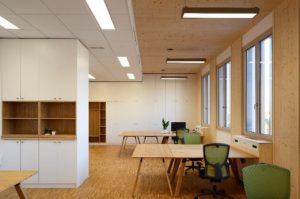
Photo: Miran Kambič
Design and construction-related services
Design and construction-related services
Graphic Design
Graphic design is needed at every step, from logos, publications, flyers to annual reports, websites, and books. Graphic design is also needed in buildings for various signs. Graphic design helps companies present themselves and show their value.
We design all types of logos, websites, books, monographs, presentation catalogs, flyers, and other promotional materials. We also design interior and exterior signage. We design exhibition layouts of various products and works of art.
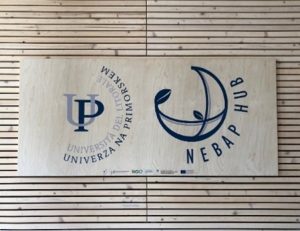
Building Information Modelling (BIM) Integration for Timber Construction
As the landscape of sustainable construction keeps evolving, it is increasingly becoming competitive. To stay ahead means embracing technologies. Integrating BIM with timber construction is a forward-thinking approach. This integration bridges the gap between advanced digital planning tools and the renewable nature of timber as a material. This approach being information oriented makes it ideal for achieving innovation and enhanced sustainability in timber construction projects.
We offer BIM solutions across all levels of BIM implementation and throughout the entire project lifecycle. From complex 3D modelling and simulations for design optimization through project coordination and collaboration to BIM-based facility management. Leveraging our expertise in wood science and engineering, we can offer custom BIM solutions specifically for timber construction to improve timber material performance, increase profitability, enhance sustainably, improved collaboration user experience.
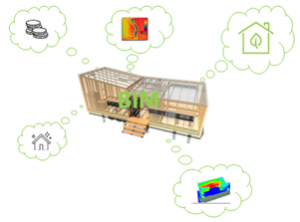
Environmental Optimization of Acoustic Solutions
Sustainable solutions and materials must find their way into all building products. Conventional materials used for acoustic purposes are not always such. For example, it is common to use expanded polystyrene for impact sound insulation and various plastic-based fibers for the construction of porous absorbers.
The interdisciplinary experts at InnoRenew CoE can support you in the development of acoustic solutions using renewable, recycled and bio-based materials. To this end, the Acoustics Lab team can perform various types of experimental characterization, while in collaboration with other research departments a more comprehensive investigation, including chemical characterization and LCA analysis, can be carried out.
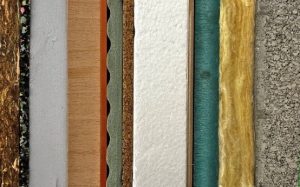
Sound Insulation Assessment
High airborne sound insulation of walls and floors is essential to achieve acoustic separation between rooms in a building. With sufficient sound insulation, privacy is maintained and independent activities in a building are made possible. The most important parameters that characterizing the sound insulation of partition elements are the sound insulation rating and the sound level difference, both of which are also generally specified as requirements for each specific building type.
Due to regulations, the sound insulation performance of a building must be evaluated in a dedicated report during the construction planning phase. This can be done with the help of laboratory measurement results, with computational approaches and also with computer simulations. All of the above approaches can be carried out by InnoRenew’s experts, who can also advise on various building details from an acoustic perspective.
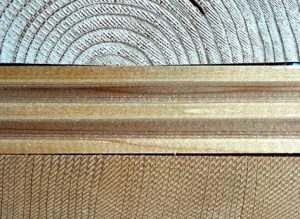
Furniture Design and Interior Design Planning
Designing attractive and innovative interior design and indoor and outdoor furniture requires a wide range of skills, from woodworking, carpentry techniques to modern CNC processing and knowledge from the latest state of wood protection and wood modification techniques.
We design wooden outdoor and indoor furniture and interior design for various rooms primarily made of wood. In our research departments we test various modifications of wood and surface protection, which enables greater creativity during design phase of wooden furniture.

Architectural and HVAC Planning of Buildings and Outdoor Arrangements
Planning wooden buildings requires specific knowledge of structural design, detailing, building physics and fire safety. Due to the many projects that we have planned, tested and also due to the research we carry out in the field of wooden buildings, we can create quality plans and inspiring architecture for the construction of new, renovation of old buildings and the design of outdoor arrangements.
We design buildings of all types and sizes. We carry out architectural plans, plans for HVAC installations, external arrangements and know the best contractors for other engineering plans, we take over the entire design process from the first drawings to the implementation plans, including the obtaining of all necessary consents and permits for construction (building permit, operating permit).
We are committed to designing new buildings and renovating existing ones from primarily natural materials (wood), with which we aim to reduce the carbon footprint of buildings and contribute to the fight against climate change.
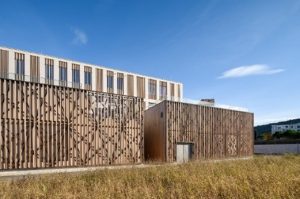
Photo: Miran Kambič
Exhibition Design
The presentation of certain products or works of art must be thoughtful, subtle, and adapted to the space in which they would be placed. We combine different types of wood into a mosaic, where the exhibits come to life in their best possible way.
We design exhibition layouts of various products and works of art.

Forensic Analysis
Digging into forensic analysis is like unlocking the secrets of how materials age and fail, and it’s key to using our resources wisely. Imagine a mix of biology, chemistry, material science, and a pinch of environmental studies all working together. It’s all about getting renewable materials from nature to our buildings responsibly, and it’s pretty much at the heart of what InnoRenew CoE is all about – making sure innovation and caring for our planet go hand in hand.
Forensic analysis isn’t just a fancy term; it’s our way of really getting to know renewable materials, all the way from their beginnings to how they end up. Think of techniques like spectroscopy and chromatography – they’re like our detectives, helping us spot things like contamination or decay that could set back our sustainability goals. And it’s not just about finding problems. It’s about creating new, tougher materials too. It’s like having a microscopic view of materials, helping InnoRenew CoE lead the charge in crafting a future that’s not just healthier, but also sticks around for the long haul.
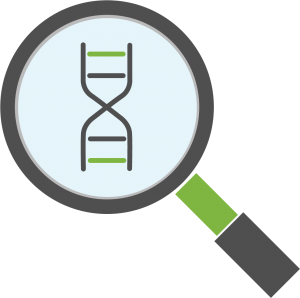
Policy development and services for governments
Policy development and services for governments
White Papers for Local, National, and International Policy Makers
White papers are powerful tools that can sway policymaking, especially on big issues like sustainability and innovation. InnoRenew CoE’s adds a crucial evidence-based element to crafting these based on our research-work. We can simply lay out the facts and make our arguments concise and specific. Our work builds bridges between the science, industry, and society to policy makers. Our goal is to make sure big decisions are rooted reliable scientific data and are going to perform optimally in the real world.
InnoRenew CoE’s involvement in creating white papers is hands-on. We’re conduct or assess research, analyse data, and work alongside other experts and stakeholders to make sure what is written is accurate and on-point. These papers push for policies that are smart, sustainable, and ready to make a difference.

Digital Product Passports
Have you heard about Digital Product Passports (DPP)? It’s an emerging system - and soon requirement – for product tracebility and life cycle management. It’s a big deal for the construction sector, revolutionising how we handle materials and products. Having all this info at your fingertips helps cut down waste and making the most of our resources. The stored data will include information about durability, repairability, recycled content, and even the aviailability of service or spare parts.
Digital Product Passport are set to become a critical feature for products in Europe and beyond. They will contain material descriptions, service life information, impact assessments, product tracibility, and, crucially, information about recycling and end of life scenarios. packing all the juicy details from when At InnoRenew CoE, we can support your implementation of DPPs. Being a forerunner in implementing DPPs will give you a competitive advantage and demonstrate your commitment to a more sustainable and circular economy.

Solutions for Resource and Product Traceability
In our highly connected world, keeping track of material and product origins is more important than ever. It’s not just about tracking the journey of materials; it’s about making sure processing and quality information are transparent.
Rapid advances in technology have allowed us to develop a complete toolbox for identifying, tagging, and monitoring materials throughout their lifetime. Innovations like blockchain, the availability of IoT technologies, leaps in data storage and processing capabilities are powerful tools in their own right. When combined with advances in scanning techniques like near infrared spectroscopy and deployed by experts with deep knowledge of the entire value-chain the barriers to implementation are easily overcome. We can help prepare customised solutions that will ease the transition towards new requirements, like digital product passports.

Services for Policymakers and Governments
Decision-makers, both local and international, face difficult choices, especially when it comes to balancing growth, technology, and sustainability. We offer several services to help policymakers make scientifically informed and data driven decisions that support healthy industry and a healthy society. By working together with policymakers, InnoRenew CoE is like a bridge, connecting research, real-world industry, and the rules and regulations, making sure the future’s not just bright but also sustainable and practical.
InnoRenew CoE offers analysis and recommendations based on deep scientific and practical understanding of wood materials and value-chains, business settings, and societal impacts. Our services have touched on circularity, technologies and building solutions to support ageing, business development, industry support, and using science to underpin decision making. InnoRenew CoE equips policymakers with what they need to navigate the complex world of modern governance, making sure progress isn’t just about growing but also about caring for our planet and each other.
Our position at the forefront of research and innovation in sustainable buildings makes InnoRenew CoE the optimal partner for turning policy into action by developing guidelines, action plans, and strategies - especially related to the Grean Deal, the Renovation Wave, and the New European Bauhaus.

Education and training for the construction ecosystem
Education and training for the construction ecosystem
Training for the Construction Ecosystem and Wood Processing Sector
The construction world is changing and staying still will set your company back. InnoRenew CoE, in collaboration with the NEBAP Hub, can keep you ahead of your competitors. Workshops, courses, and hands-on training are combined to provide enganging education for stakeholders across the wood-construction ecosystem. Our course selection provides the exact skills needed to be on the cutting-edge of wood-based construction. Through collaboration with the NEBAP HUB, microcredentials are available to learners.
The New European Bauhaus Academy Pioneer Hub (NEBAP Hub), located on-site at the InnoRenew CoE building in Izola, Slovenia provides accredited training by experts on a wide variety of topics relevent to construction ecosystem stakeholders. Topics include, co-creation technqiques, artificial intelligence in architecture, quality assessment, NEB principles, wood properties and mechanics, building with wood, and many other subjects With the microcredential system, you can choose quality-certified courses to customise your learning journey. Our trainings are enhanced through collaborations with specialist companies, like Optik Instruments, who provide deep knowledge in their field.
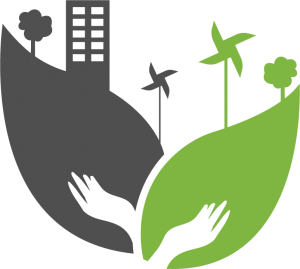
Training for Engineers and Architects on Using Wood in Buildings
The specific knowledge required for planning large wooden buildings is demonstrated and shown through the example of the InnoRenew CoE Building in Izola.
We provide trainings in the field of construction of large wooden buildings for engineers of various disciplines and for architects. Training includes presentation of architecture, building structures, HVAC installations, fire safety, moisture monitoring, wood protection, design of reliable details and demonstration of material’s testing in our laboratories.
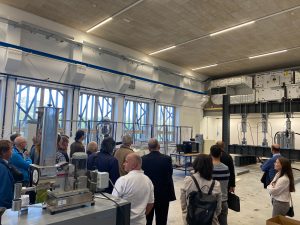
Dedicated Educational Events for Primary Schools
Since 2019, InnoRenew CoE has organized wood promotion and woodworking workshops for hundres of primary school students across seven Slovenian regions. With positive feedback and ongoing interest, the workshops aim to shape attitudes, raise awareness of responsible behavior, emphasize the importance of wood, and enhance related knowledge and skills.
Different versions of educational events are possible:
- Option 1 offers 45- or 90-minute workshops at InnoRenew CoE’s building in Izola or onsite at Slovenian elementary schools, focusing on wood species identification, wood properties, tool usage, and the importance of natural science.
- Option 2 provides two or three-day workshops at InnoRenew CoE in Izola for 8th and 9th-grade students, guiding them in research, fostering innovative thinking, and enhancing knowledge and skills related to wood use through hands-on activities. Students will create wood-based composites, exploring fungi roles, and consider wood as a concrete replacement.
- Option 3 involves a one-day visit to InnoRenew CoE’s Izola building for career orientation, presenting various research professions like microbiology, kinesiology, architecture, renewable composites, and sustainable construction to help students explore career paths and recognize different options.
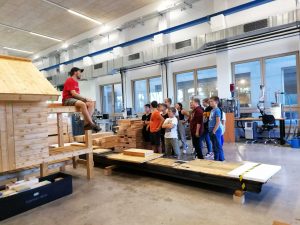
Training on EN Standards for Laminated Timber Products
The production of laminated timber products, e.g., cross-laminated timber (CLT) and glued laminated timber (GLT), can follow certain harmonized EN standards or other regional standards. These standards normally include sections describing equipment, testing, and minimum production requirements e.g., for finger jointing, cross-cutting of defects, bonding of laminations, etc. which are necessary in order to fulfill compliance with the relevant standard.
Training on the use of EN standards is provided for the production and testing of laminated timber products. Training can be organized for small and large groups and will include both theoretical and practical components.
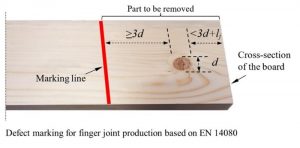
Open Days for High Schools
Earth Day, observed globally every April 22, promotes environmental awareness and actions for sustainability, emphasizing the importance of preserving the planet. To align with this commitment, InnoRenew CoE organizes workshops for high schoolers, exploring sustainability, the built environment, materials, and innovations for environmentally friendly and comfortable buildings.
A two-hour workshop for high school students at InnoRenew CoE in Izola consists of a theoretical part covering sustainability discussions, environmental impacts, carbon cycling, wood’s carbon footprint, cascading, and restorative environments.
In the practical part:
- Option 1 focuses on sustainable building practices, including acoustics, safety technology, environmental impact assessment, manufacturing processes, and material usage.
- Option 2 concentrates on materials, exploring hardness, outdoor wood enhancements, wood densification, and collaborative creation of composite materials for improved design, functionality, and environmental sustainability.
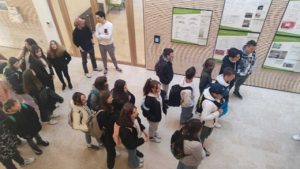
Guided Topical Tours of InnoRenew CoE Building
The InnoRenew CoE building was constructed in 2021. It is a hybrid combination of timber, concrete and steel. The upper three floors of the main building are entirely wooden, making it the largest wooden building in Slovenia to date. The building houses offices, meeting rooms and research laboratories. It is built according to verified principles of contemporary sustainable building construction. The interior of the building is designed and equipped following the principles of restorative environmental and ergonomic design (REED), which emphasizes the use of natural materials to create ergonomic, accessible, adaptable and sustainable buildings.
Customisable tour packages for groups include an overview of the InnoRenew CoE rooms and research laboratories with an expert guide, and the presentation of construction process of the building, and specific details upon request.
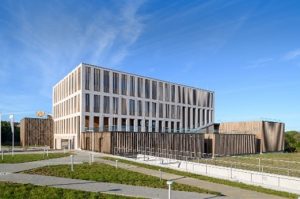
Foto: Miran Kambič
Training on Industrial and Business Process Optimisation
The optimisation of industrial and business processes is a critical aspect of maintaining efficiency and competitiveness. Knowledge of state-of-the-art tools and techniques can help with this.
Our training program is designed to provide individuals with the necessary skills to analyze and optimize various industrial and business processes. The training begins with an introduction to the fundamentals of process optimization, followed by an exploration of industry-specific challenges and solutions. Participants will learn how to use computational models to optimize production schedules, employee assignments, and other operations aspects. The program also includes practical exercises and case studies to provide hands-on experience.
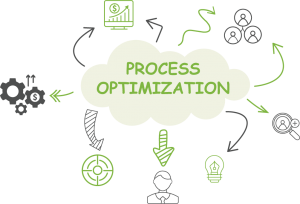
FAIR Data Management Training
Open science is fundamental for ensuring the transparency, accessibility, and reproducibility of scientific research. A crucial element of open science is the implementation of research data management in line with FAIR principles – that is, findability, accessibility, interoperability, and reusability. Research funding organizations now expect researchers to adhere to these principles as part of their projects, ensuring that data generated is not only robust but also adheres to standards that facilitate broader dissemination, collaboration, and the overall advancement of scientific knowledge.
Participants will be introduced to key concepts in open science and research data management. They will learn how to prepare a research data management plan and apply FAIR principles of data sharing by using recommended metadata schemes and file formats, select the most appropriate repository and prepare thorough documentation to ensure the reusability of data. The workshop content is relevant for researchers from different scientific fields.

AI Training for the Construction Sector
Learning about Artificial Intelligence (AI) is essential today because it’s a driving force in technological innovation, influencing every sector from healthcare and finance to wood production and construction. Understanding AI is also crucial for addressing ethical and societal challenges, as AI systems increasingly impact our daily lives. Additionally, AI literacy is becoming important in decision-making processes in businesses and governments, making AI knowledge a valuable asset across multiple domains.
Our specialized course created for professionals in the construction sector aims to teach you how to integrate machine learning toolset and AI in your day-to-day activities. The course offers an in-depth exploration of machine learning basics, discussing its pivotal role in the evolution of the construction sector. Participants will attain an thorough overview of how data can be used to support our daily decisions and transformed into strategic insights. The topics we cover include a theoretical overview of the different machine learning and AI techniques together with interactive sessions dedicated to solving real-world problems and construction-related challenges, as well as hands-on exercises to build up and understand the different parts of the machine learning workflow from collecting the data to evaluating and using our final models. Regardless of the technical proficiency of the participant, this course aims to help you understand the basics of new digital technologies that are already transforming the way we work. We encourage you to harness the potential of these new digital technologies to elevate your efficiency and avoid being left behind in the rapidly advancing architectural landscape.
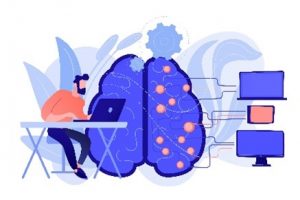
Survey Methods Training
Surveys are integral for collecting data on different topics or issues in various domains, ranging from academia to industry. With declining response rates, it can be challenging to get sufficient responses to provide valid and reliable data. In addition, designing effective survey questionnaires to collect high-quality data is a challenging task.
Participants will get a comprehensive understanding of different survey methods, along with practical insights into the entire survey process, from selecting appropriate sampling procedures, to designing effective survey questionnaires.

Communication and event organization
Communication and event organization
Communication Strategy Development (including press and social media strategy)
The development of a communication strategy is crucial for organizations, businesses, and individuals to effectively convey their messages to their target audiences.
Based on your goals and needs we can develop a comprehensive strategy outlining how an organization or individual intends to communicate communication with its target audience to achieve specific goals. Including: setting objectives, defining target audiences, key messages, communication channels, media, social media, content calendars, monitoring and evaluation, feedback, etc.

Implementation of Communication Activities
Communication is an integral part of any organisation. We can help you put your communication strategy in motion. Start engaging your target audiences more effectively to reach your organisation’s goals.
Based on your goals and needs we can help you setup and manage your website and social media profiles, support graphic design, coordinate newsletters and their distribution, and communicate science more effectively to to general public.

Event Organization (scientific conferences, workshops, partners/project meetings)
InnoRenew CoE can help you organise and host different types of events to share your achievements and knowledge with the wider audience.
We can provide organisational and logistical support to make your event run smoothly in an ideal setting. Our services include setting up conference webpages, information on venues, logistics, and accommodation; programme design, collecting contributions, registrations; onsite support during the event, including photography, video productions; and communication to participants after the event.

Other
Other
Teambuilding Programmes for Companies
Based on your needs we can organize teambuilding events designed to enhance your teams to creativity and collaboration.
Working together to overcome challenges and problem solve in a scientific settings is a unique opportunity for your team to learn new skills, learn to rely on each other, and express their creativity in new ways. We can arrange exercises in our labs that help your team grow together.

Space Rentals
The InnoRenew CoE building houses 5 conference rooms perfect for different type of events, including simulteanous translation.
Our conference and meeting rooms can accomodate groups of all sizes with space conference rooms for 80 and 100 people, and meeting rooms for 20 to 40 people. All rooms are equipped with interactive whiteboards, high-resolution projectors, and a sound system. Furniture can be arranged to match your events needs. Space rentals may opt to include our 190 square meters of open lounge space on the first floor is available and can accommodate a wardrobe, catering, exhibitions, small stands, two screens for video projection, and a sound system.
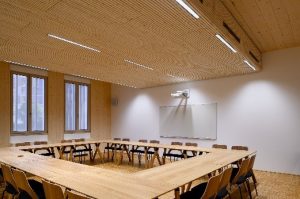
Foto: Miran Kambič
Assistance with Public Procurement Procedures in Slovenia
Public procurement is a time-consuming and often difficult process, especially for unique projects like buildings. We can help your firm navigate public procuremement in Slovenia to ensure your project is realised as planned and on budget. Our experience in public procurement extends well-beyond buildings and includes services, technical and scientific equipment, utilities, etc.
The successful implementation of the project “Centre of Excellence for Research and Innovation in Renewable Materials and Healthy Living Environments (InnoRenew CoE)” and our other experience has provided us with the knowledge and expertise to provide advice and assistance in managing infrastructure projects from the co-financing decision onwards. Based on this experience we can provide advice on tender documentation, selection of construction contractors or equipment suppliers, through to implementation and handover, and preparation of co-financing applications and reporting.
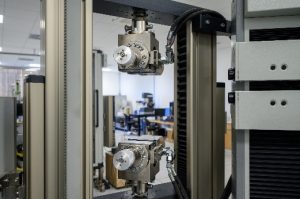
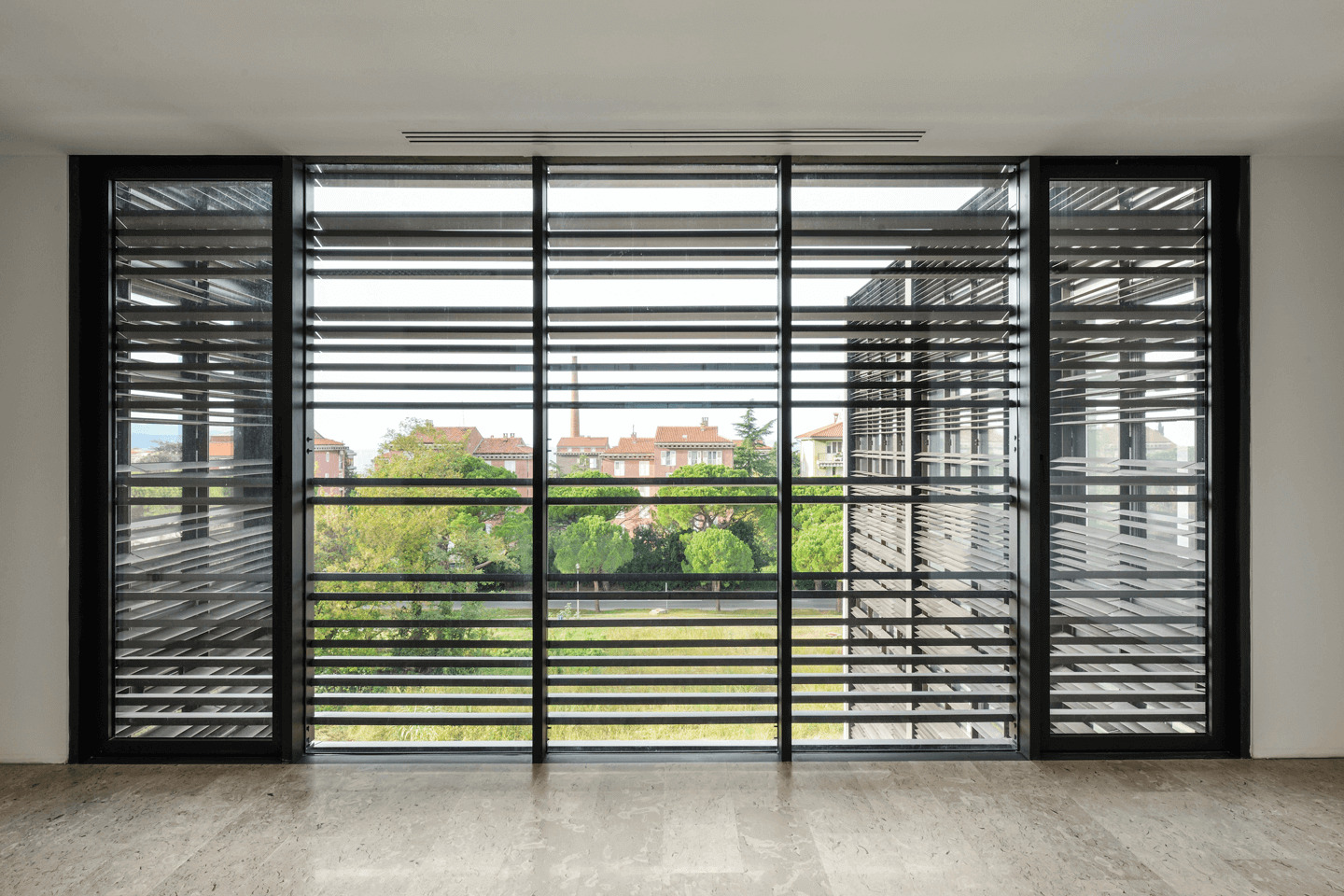
Partnering for public calls
The InnoRenew CoE is ready to join your project consortium to add our expertise across the forest products value chain from materials research, to industrial optimization, building with wood, environmental impacts, and human health.
E-mail coe@innorenew.eu for more information.

Assisting SME’s in public funding
SME’s may apply for funding from a variety of calls for proposals specifically designed for them under Horizon Europe programme. If you are interested in growing your business this way, we will be glad to assess your plans and help you determine if the Horizon Europe SME instrument is right for you. If it is, we can help you prepare your proposal and work with you to implement the project when you are successful.
E-mail coe@innorenew.eu for more information.
Other services
As the InnoRenew CoE grows we will expand our services to provide a wider variety of industrial research, training, and consulting services. If you need help with a project, or want to learn more about the availability of these services now, please e-mail coe@innorenew.eu.
